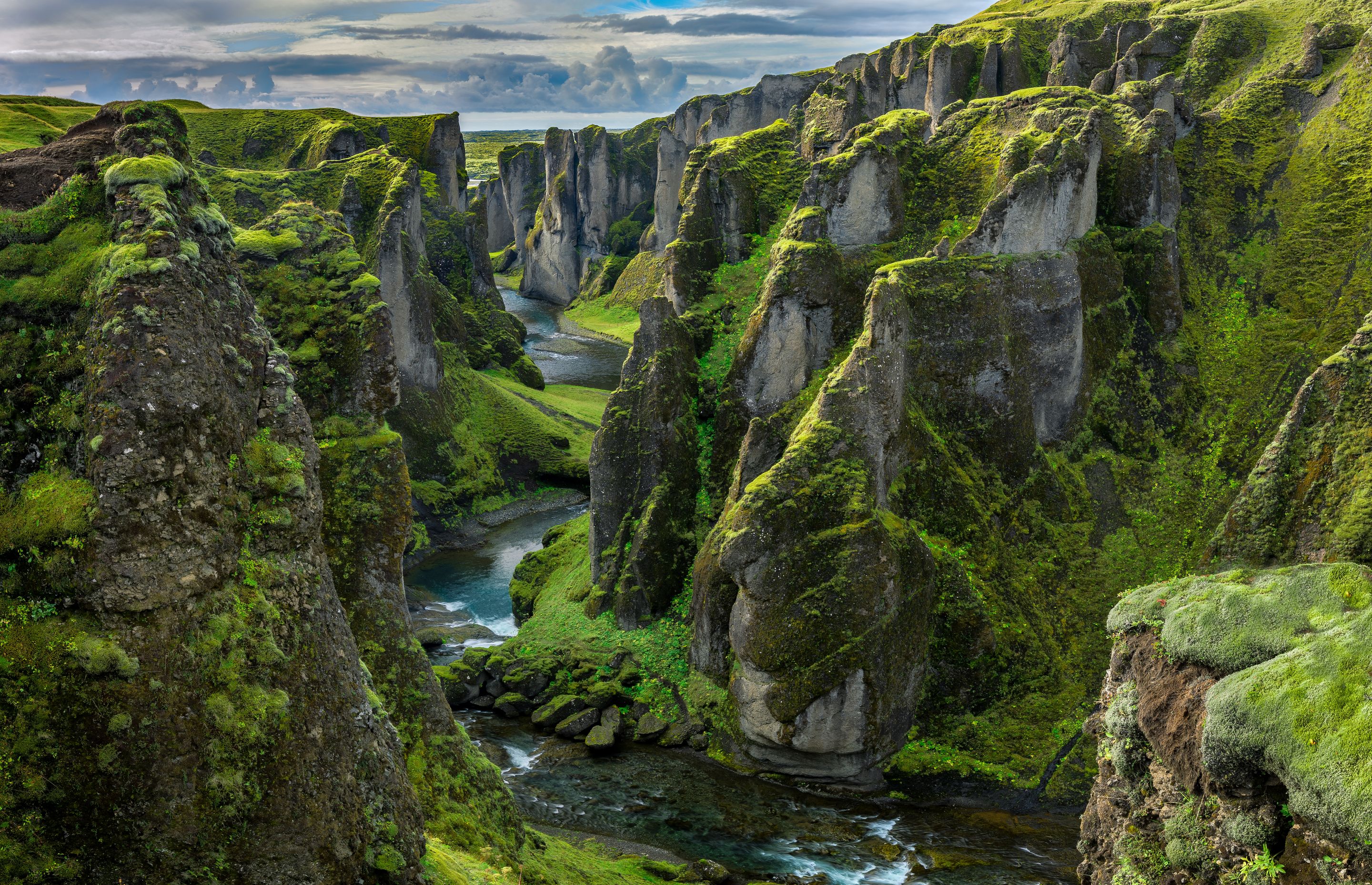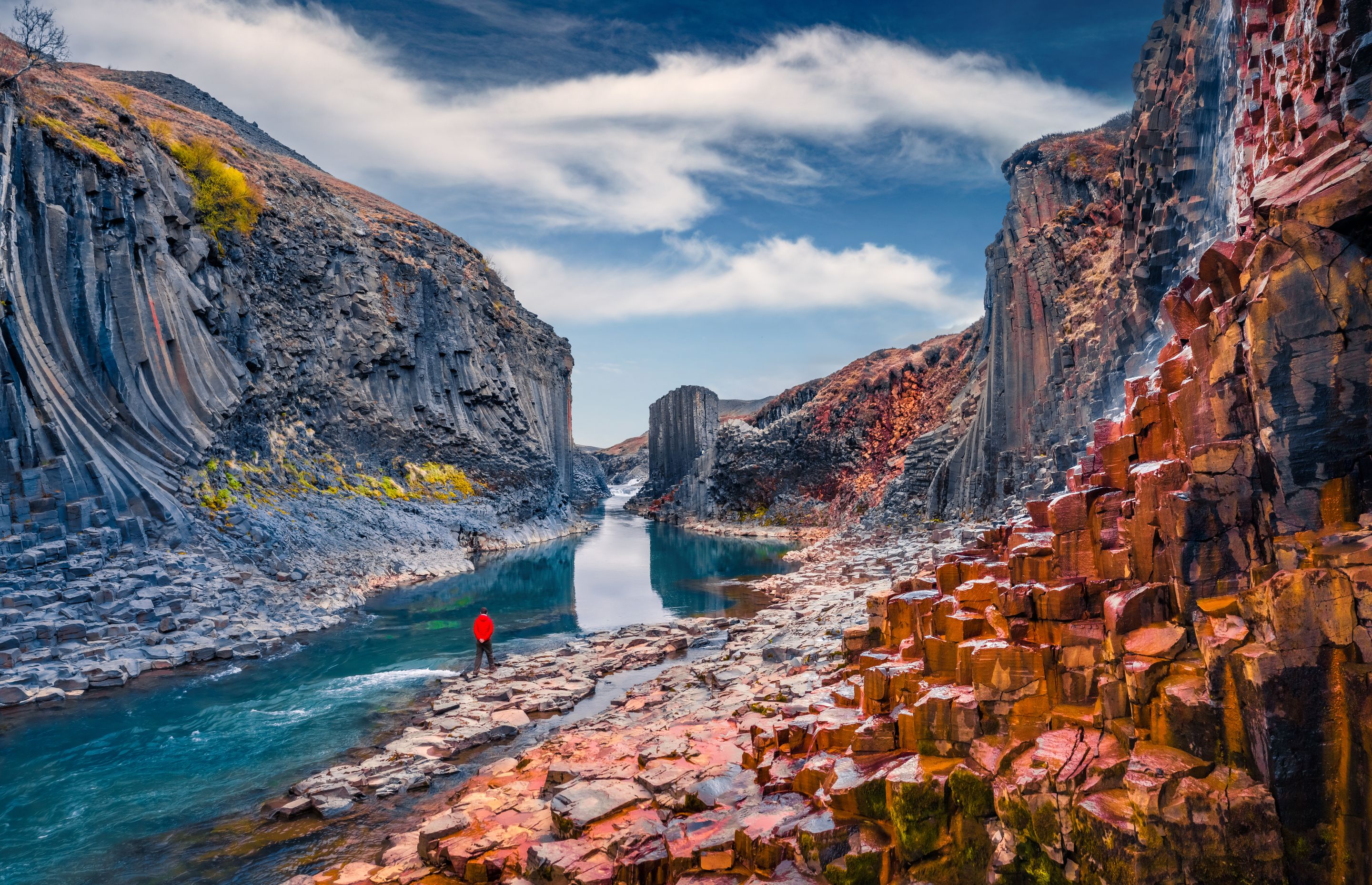
Fjaðrárgljúfur Canyon, a marvel carved in stone
Jump to chapter
Iceland is a land of incredible geographical and geological variety. The different kinds of landscapes here are amazing, and nature seems to have gone a little bit crazy in creating some of the most breathtaking places on Earth. Some have gained international fame, but others are not so well-known to visitors. One of them is the astonishing Fjaðrárgljúfur Canyon in the south of the country.
This place, carved out by a winding river, has dramatic cliffs and rocks covered by a beautiful layer of green moss. Whether you are an adventurer seeking new trails, a photography lover, a nature enthusiast, or just a person who loves seeing amazing places, Fjaðrárgljúfur should be on your Iceland travel list.
Key Takeaways
- Fjaðrárgljúfur is a canyon located in South Iceland.
- It’s 2 kilometers (1.25 miles) long, and its walls reach 100 meters (328 feet) tall.
- The canyon is located in a region full of natural wonders that are worth a visit.
What’s Fjaðrárgljúfur Canyon?
Fjaðrárgljúfur is a stunning canyon located in south Iceland. It has a length of about 2 kilometers (1.25 miles) and is up to 100 meters (328 feet) deep at its highest part. The Fjaðrá River has carved the canyon as it flows through it, snaking its way between the tall rock walls covered in a beautiful blanket of green moss. The name Fjaðrárgljúfur can be translated as “feather river canyon”. Gljúfur means canyon in Icelandic.
The canyon is believed to have been formed more than 9,000 years ago during the last Ice Age. As glaciers melted, massive amounts of water eroded the rock, leaving behind this astonishing landscape. The rock formations found in Fjaðrárgljúfur are mostly palagonite, a type of volcanic rock formed when lava cools very quickly in water. This gives the canyon its unique and rugged texture.
The canyon has been around for thousands of years, and Icelanders have known and visited it throughout history. However, it remained relatively unknown to tourists until 2015, when Justin Bieber recorded the video clip for his song "I’ll Show You." Suddenly, Fjaðrárgljúfur became a popular destination, as many travelers wanted to see this outstanding place. The increase in the number of visitors even led the local authorities to temporarily close the canyon to protect its fragile ecosystem.
In the canyon, it’s easy to see the impact that time, water, and volcanic activity have had on this natural monument. The contrast between the color of the water, of a deep blue, the dark rocks, and the green moss is simply marvelous, making it one of Iceland’s most picturesque spots.


Why is the Fjaðrárgljúfur Canyon Worth Visiting?
Fjaðrárgljúfur is easy to get to, right off the Ring Road near Kirkjubæjarklaustur. The cool thing is there’s a short trail that runs along the edge of the canyon with several viewpoints from where you can look straight down at the river. The walk is very nice, the surroundings are also beautiful, and there’s literally no noise at all.
The hike is about 2 kilometers round trip, simple to walk, and doesn’t take long. The path is well-maintained and mostly flat, so almost anyone can do it. I last visited in May 2023 with some of my friends, and we were completely alone.

Where’s Fjaðrárgljúfur Canyon and How to Get There
Fjaðrárgljúfur Canyon is located in south Iceland, not far from the small village of Kirkjubæjarklaustur. It’s just off Route 1, also known as the Ring Road, the main road in Iceland. For this reason, it’s an easy stop if you’re traveling to this part of the country.
The route to Fjaðrárgljúfur from Reykjavik is quite easy and straightforward. It takes approximately three and a half hours, covering around 255 kilometers (158 miles). The journey is part of the experience, as the landscapes you’ll see from the road are amazing. It also passes close to some of Iceland’s most famous landscapes, including black sand beaches, waterfalls, and lava fields.
If you’re coming from the capital by car, start taking Route 1 heading east. Along the way, you’ll pass through towns like Selfoss, Hella, and Vík, all making great stops for food and rest breaks. Before reaching Kirkjubæjarklaustur, you’ll come across Road 206, also called Holtsvegur. Turn onto this road and follow it for about 3 kilometers (1.86 miles) until you reach the designated parking area for the canyon. The parking area is very close to the start of the trail.
Be aware that Road 206 is not paved. While a regular car can usually handle the drive in good weather, it can become difficult in winter conditions. If you visit during the colder months, a 4x4 vehicle is recommended, as ice and snow can make the road tricky to navigate.
The Weather at Fjaðrárgljúfur Canyon
The weather in Iceland is, in general, unpredictable and can change at a moment’s notice. This part of the country is also one of the wettest and windiest, which can add an extra layer of variability. Here’s what you can expect season by season:
Spring (April and May)
Spring in Iceland is a transition period. The snow begins to melt, revealing the landscape underneath. Temperatures range from 0°C to 10°C (32°F to 50°F), and rain showers are common. The roads become more accessible, and the moss in the canyon starts getting its bright green color again.
Summer (June to August)
The best time to visit for clear weather. The temperatures in this season usually move between 10°C and 15°C (50°F to 59°F). The daylight hours are very long, which allows plenty of time to visit the canyon with natural light. On the other hand, it’s peak season, so expect crowds.
Autumn (September and October)
At this time, the temperatures start to go down, averaging 5°C to 10°C (41°F to 50°F). There are fewer tourists, so the visits are quieter and give you more space to explore at your own pace. It’s common to have rain and wind.
Winter (November to March)
Snow transforms the canyon into a magical place, but travel conditions can be harsh. The temperatures often drop below freezing, and many roads close due to snow and ice. If you’re coming in winter, it’s essential to rent a 4x4 car and plan everything with extra care.

What to See and Do Near Fjaðrárgljúfur Canyon
One of the best things about Fjaðrárgljúfur Canyon is that it can be easily added to a route to the southern region of Iceland. This place is worth a visit on its own, but here you have a few things you can see and do nearby.
Jökulsárlón Glacier Lagoon
This astonishing natural monument is a bit further east from the canyon. This lagoon is filled with floating icebergs that have broken off from the nearby Vatnajökull Glacier. Some of these big chunks of ice are deep blue. After drifting on the lake for days, weeks, and even months, many of them drift out to the sea, and some end up at the famous Diamond Beach, which is quite close. The contrast of the ice with the dark sand is simply spectacular.


Vatnajökull National Park
It’s one of the three national parks in Iceland and the largest national park in Europe. Vatnajökull is home to Iceland’s biggest glacier and many other natural wonders. The park offers a range of outdoor activities, including guided glacier hikes, visits to ice caves, and mountain treks. The diversity of landscapes inside the park makes it one of Iceland’s most extraordinary destinations.

Katla Ice Cave
Located near the town of Vík, this spectacular ice cave offers the chance to see the inside of a glacier. Katla Ice Cave is impressive, with its deep blue ice with black streaks, which are marks left by volcanic ash. For safety reasons, it’s necessary to visit on a guided tour.

Fjallabak Nature Reserve
Fjallabak is a paradise for those looking to escape the usual tourist routes. The area is known for its colorful rhyolite mountains, volcanic formations, and several geothermal hot springs. The reserve is home to various hiking trails if you’re up for a challenge. Some of them are hard, but they reward hikers with great views of lava fields, rivers, and glacial valleys.

Laugavegur Trail
This hiking route, located in the Highlands, is probably the most famous trail in Iceland. The Laugavegur Trail begins at Landmannalaugar, an area known for its colorful mountains and geothermal activity. The trail goes through a variety of beautiful landscapes. It’s a 55-kilometer (34-mile) route that takes three to four days to complete, and there are mountain huts and campsites where you can spend the night. The trail can only be done in the summer months, as the roads in this region close the rest of the year because of the harsh weather.

Travel Tips for Visiting Fjaðrárgljúfur Canyon
Visiting Fjaðrárgljúfur is simple, but it's always good to plan ahead.
- Check road conditions: The gravel road leading to the canyon can be closed if the weather is adverse. Always check the Icelandic Road and Coastal Administration website before setting off.
- Stay on marked trails: The moss covering the canyon is extremely delicate and can take decades to recover if it is damaged. To help preserve the area's natural beauty, stick to designated paths.
- Check the weather forecast: Iceland’s weather changes rapidly, and conditions can shift within minutes. Before you head out, check the weather forecast to have a safe and comfortable visit.
- Pack smart: Bring waterproof clothing and sturdy hiking shoes, and dress in layers to adapt to changing conditions. The canyon does not have services, so pack food and water for your trip. There’s a small toilet at the end of the trail, but the last time I went, it was closed.
- Visit during off-peak hours: In the summer, to avoid crowds, visit the Fjaðrárgljúfur Canyon early in the morning or late in the evening.
Conclusion
Fjaðrárgljúfur Canyon is one of Iceland’s most incredible natural wonders. And that’s saying a lot. But this place is so beautiful and picturesque, with its amazing color contrasts, that it seems like a surreal natural feature. It’s a fantastic option to add to an itinerary through South Iceland, and it’s close to some of the best things to see in the country. Seeing this place is certainly a memory that you’ll take with you forever.




